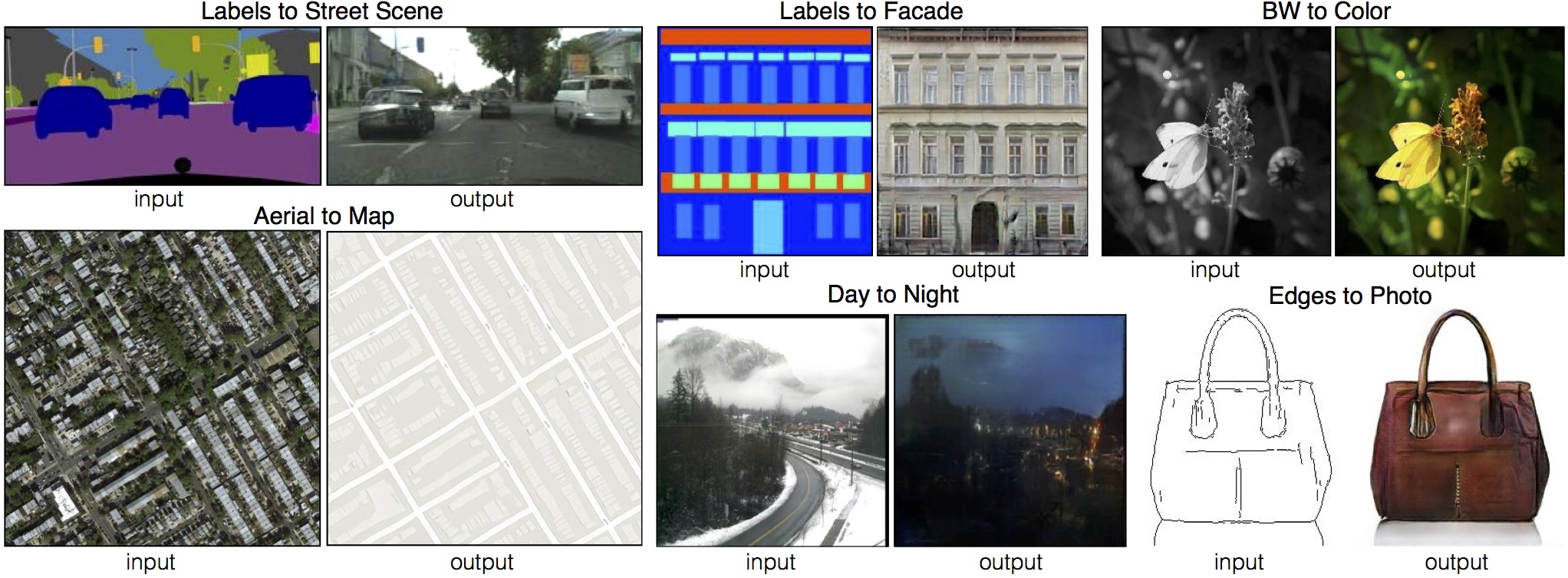Torch implementation for learning a mapping from input images to output images, for example:
Image-to-Image Translation Using Conditional Adversarial Networks
Phillip Isola, Jun-Yan Zhu, Tinghui Zhou, Alexei A. Efros
In arxiv, 2016.
On some tasks, decent results can be obtained fairly quickly and on small datasets. For example, to learn to generate facades (example shown above), we trained on just 400 images for about 2 hours (on a single Pascal Titan X GPU). However, for harder problems it may be important to train on far larger datasets, and for many hours or even days.
- Linux or OSX
- NVIDIA GPU + CUDA CuDNN (CPU mode and CUDA without CuDNN may work with minimal modification, but untested)
- Install torch and dependencies from https://github.com/torch/distro
- Install torch packages
nngraphanddisplay
luarocks install nngraph
luarocks install https://raw.githubusercontent.com/szym/display/master/display-scm-0.rockspec- Clone this repo:
git clone git@github.com:phillipi/pix2pix.git
cd pix2pix- Download the dataset (e.g. CMP Facades):
bash ./datasets/download_dataset.sh facades- Train the model
DATA_ROOT=./datasets/facades name=facades_generation which_direction=BtoA th train.lua- (CPU only) The same training command without using a GPU or CUDNN. Setting the environment variables
gpu=0 cudnn=0forces CPU only
DATA_ROOT=./datasets/facades name=facades_generation which_direction=BtoA gpu=0 cudnn=0 batchSize=10 save_epoch_freq=5 th train.lua- (Optionally) start the display server to view results as the model trains. ( See Display UI for more details):
th -ldisplay.start 8000 0.0.0.0- Finally, test the model:
DATA_ROOT=./datasets/facades name=facades_generation which_direction=BtoA phase=val th test.luaThe test results will be saved to an html file here: ./results/facades_generation/latest_net_G_val/index.html.
DATA_ROOT=/path/to/data/ name=expt_name which_direction=AtoB th train.luaSwitch AtoB to BtoA to train translation in opposite direction.
Models are saved to ./checkpoints/expt_name (can be changed by passing checkpoint_dir=your_dir in train.lua).
See opt in train.lua for additional training options.
DATA_ROOT=/path/to/data/ name=expt_name which_direction=AtoB phase=val th test.luaThis will run the model named expt_name in direction AtoB on all images in /path/to/data/val.
Result images, and a webpage to view them, are saved to ./results/expt_name (can be changed by passing results_dir=your_dir in test.lua).
See opt in test.lua for additional testing options.
Download the datasets using the following script:
bash ./datasets/download_dataset.sh dataset_namefacades: 400 images from CMP Facades dataset.cityscapes: 2975 images from the Cityscapes training set.maps: 1096 training images scraped from Google Mapsedges2shoes: 50k training images from UT Zappos50K dataset. Edges are computed by HED edge detector + post-processing.edges2handbags: 137K Amazon Handbag images from iGAN project. Edges are computed by HED edge detector + post-processing.
Download the pre-trained models with the following script. You need to rename the model (e.g. facades_label2image to /checkpoints/facades/latest_net_G.t7) after the download has finished.
bash ./models/download_model.sh model_namefacades_label2image(label -> facade): trained on the CMP Facades dataset.cityscapes_label2image(label -> street scene): trained on the Cityscapes dataset.cityscapes_image2label(street scene -> label): trained on the Cityscapes dataset.map2sat(map -> aerial photo): trained on Google maps.sat2map(aerial photo -> map): trained on Google maps.edges2shoes(edge -> photo): trained on UT Zappos50K dataset.edges2handbags(edge -> photo): train on Amazon handbags images.day2night(daytime scene -> nighttime scene): trained on around 100 webcams.
We provide a python script to generate training data in the form of pairs of images {A,B}, where A and B are two different depicitions of the same underlying scene. For example, these might be pairs {label map, photo} or {bw image, color image}. Then we can learn to translate A to B or B to A:
Create folder /path/to/data with subfolders A and B. A and B should each have their own subfolders train, val, test, etc. In /path/to/data/A/train, put training images in style A. In /path/to/data/B/train, put the corresponding images in style B. Repeat same for other data splits (val, test, etc).
Corresponding images in a pair {A,B} must be the same size and have the same filename, e.g. /path/to/data/A/train/1.jpg is considered to correspond to /path/to/data/B/train/1.jpg.
Once the data is formatted this way, call:
python scripts/combine_A_and_B.py --fold_A /path/to/data/A --fold_B /path/to/data/B --fold_AB /path/to/dataThis will combine each pair of images (A,B) into a single image file, ready for training.
No need to run combine_A_and_B.py for colorization. Instead, you just need to prepare some natural images, and set preprocess=colorization in the script. The program will automatically convert each RGB image into Lab color space, and create L -> ab image pair during the training.
We provide python and Matlab scripts to extract coarse edges from photos. Run scripts/edges/batch_hed.py to compute HED edges. Run scripts/edges/PostprocessHED.m to simplify edges with additional post-processing steps. Check the code documentation for more details.
Optionally, for displaying images during training and test, use the display package.
- Install it with:
luarocks install https://raw.githubusercontent.com/szym/display/master/display-scm-0.rockspec - Then start the server with:
th -ldisplay.start - Open this URL in your browser: http://localhost:8000
By default, the server listens on localhost. Pass 0.0.0.0 to allow external connections on any interface:
th -ldisplay.start 8000 0.0.0.0Then open http://(hostname):(port)/ in your browser to load the remote desktop.
L1 error is plotted to the display by default. Set the environment variable display_plot to a comma-seperated list of values errL1, errG and errD to visualize the L1, generator, and descriminator error respectively. For example, to plot only the generator and descriminator errors to the display instead of the default L1 error, set display_plot="errG,errD".
If you use this code for your research, please cite our paper Image-to-Image Translation Using Conditional Adversarial Networks:
@article{pix2pix2016,
title={Image-to-Image Translation with Conditional Adversarial Networks},
author={Isola, Phillip and Zhu, Jun-Yan and Zhou, Tinghui and Efros, Alexei A},
journal={arxiv},
year={2016}
}
Code borrows heavily from DCGAN. The data loader is modified from DCGAN and Context-Encoder.
